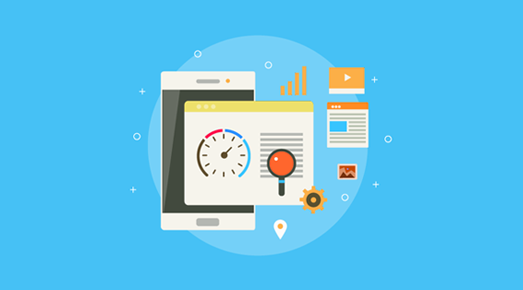Page speed can easily be defined as the time it takes to display the content on a specific web page. Page speed is the loading time of a specific page on your website, or how long your content and images take to show up. Testing for each page, or particularly for your most important pages, can reveal critical weaknesses and flaaws in your site’s performance.
What is Page Speed?
Page speed is often thought as site speed. Although they are similar, they are not the same. Site speed is the average of several sample pages on a website. Page speed can be described in either time to receive a web page’s first byte (the time your browser will receive from the web server the first byte of information) or “page load time” which how long it takes to fully display the content on a specific page.
Page speed (probably) constitutes an important ranking factor in Google’s algorithm. Not only does it play a role in ranking, it plays a role in user experience (Google might argue that “experience” and “rank” should be inextricably linked). Pages that take a long time to load can increase your bounce rate and lower the average session duration, resulting in fewer interactions and decreased conversions.
It’s essential to identify what is causing pages on your site load slowly and to use effective tools and methods to optimize your page speed. Implementing those optimizations can improve your rankings and, through better user experience, the important conversion rate.
SEO Best Practices
Page speed is important to users since faster pages are more efficient because, if a page takes too long to load, most of the users will click away from that page. Page speed is also important for Search Engine Optimization.
Google has indicated site speed (and as a result, page speed) is one of the signals used by its algorithm to rank pages as announced in 2010. And studies have shown that when Google considers page speed, it might be precisely measuring time to the first byte.
Page speed is also essential to user experience. Pages with a longer load time tend to have lower average time on page and higher bounce rates because naturally, we don’t have the same level of patience. Longer load times have also been shown to negatively affect conversions.

WAYS TO INCREASE YOUR PAGE SPEED
Enable file compression
To get this done, use Gzip. This is a software application that is used basically for file compression, to reduce the size of your HTML, CSS, and JavaScript files that are larger than 150 bytes.
Do not use azio to compress image files. Instead, to maintain the quality of the image, compress images in a program 11,e Photoshop.
Minify CSS. JavaScript, and HTML
You can increase page speed by optimizing your code (including removing commas, spaces, and other unnecessary characters). To reduce ambiguity, you have to remove code comments, formatting. and unused code. Google recommends using CSSNano and UglifyJS for best results.
Reduce redirects
Each time a page redirects to another page, the page user faces additional time waiting for the HTTP request-response cycle to complete and this will take more time than loading a normal page. For example, if your mobile redirect pattern looks like this: “example.com www.example.com -› m.example.com -> m.example.com/home,” each of those two additional redirects takes longer time, thus, it makes your page load slower.
Remove render-blocking JavaScript
Before browsers can render a page, they need to build a DOM (Document Object Model) tree by parsing HTML. Your browser has to discontinue and execute it before it can move forward if it encounters a script during this process. This will definitely make the page load slower so it’s best to remove it. It’s best to avoid and minimize the use of blocking JavaScript.
Leverage browser caching
Browser caching is an excellent way to maximize your page speed because when a user visits your site again, it would not take long to load. You have to know that browsers cache a lot of information (images, stylesheets. JavaScript files, and more) so that when a page user returns to your site, it doesn’t have to reload the entire page. Mostly, a year is a reasonable time period to keep your cache settings unless your site design changes frequently. YSlow is a necessary tool to know the expiration date set for your cache.
Improve server response time
The amount of traffic you receive dramatically affects your server response time, the hosting solution you use, the software your server uses, and the resources each page uses. If you want to improve your server response time, find performance bottlenecks like slow routing, slow database queries, or a lack of adequate memory and fix them. The optimal server response time is under 200ms. Find out more about optimizing your, time to first byte for it will enhance your page speed.
Use a content distribution network
Also called content delivery networks, content distribution networks (CDNs) are networks of servers that are utilized to assign the load of delivering content. Fundamentally, copies of your site are put in storage at multiple, geographically diverse data centers so that visitors have quicker and better access to your site with fast loading speed.
Optimize images
Always remember that your images must be no larger than they should be, that they are in the right file format (JPEGs are basically better on photographs while PNGs are basically better for graphics with fewer than 16 colors) and that they are compressed tor the web.
To create a template for images, use CSS sprites on your site like buttons and icons. CSS sprites integrate your images into one large image that loads all at once and then show only the sections that you want to display since it is fewer HTTP requests. ,By not making the users wait for multiple images to load, this means that you are saving load time. By using this method, your page will bad faster.
Now that you know what mistakes to avoid and understand the most important elements of page speed optimization, you can get to work! Following these best practices not only results in a faster website, but a better user experience for visitors and favor from Google. Remember, each site is unique and needs to be optimized accordingly. With these benefits in mind, it’s worth making time for page speed optimizations.


